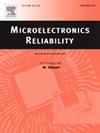ESD Human Body Model step stress distributions of GaN HEMTs and the correlation with one level test results
IF 1.6
4区 工程技术
Q3 ENGINEERING, ELECTRICAL & ELECTRONIC
引用次数: 0
Abstract
Evaluation of the Electro Sensitivity Discharge (ESD) robustness of Radio Frequency (RF) GaN HEMTs can result in different Human Body Model (HBM) ESD classifications due to different sample sizes, batch-to-batch variations, different test methodology and differences in the test set-up. For example, a low sample sizes per voltage level can lead to a higher classification level.
Two GaN HEMTs processed in the same technology with different power ratings were investigated with (i) step stress testing, and (ii) with testing at one voltage level, using different test set-ups and different wafer and assembly batches. A lognormal distribution gives a good fit for the HBM failure voltages acquired from step stress testing and can quantify the differences between GaN HEMTs, test set-ups and different batches.
The failure percentages observed with one level testing can be significantly lower than what is expected based on the step stress HBM failure distribution. Furthermore, the spread observed in the HBM failure distributions acquired by testing at one voltage level is significantly larger than the spread observed in the HBM failure distribution as determined by step stress testing.
The differences between one level and the step stress failure distribution can be explained by presence of traps inside the GaN HEMT devices.
Furthermore, the ESD classification according to JS-001 [1] is discussed and how Operating Characteristics (OC) curves can be used to compare ESD test plans with different sample sizes and number of failures observed.
GaN hemt的ESD人体模型阶跃应力分布及其与单水平测试结果的相关性
由于不同的样本量、批次之间的差异、不同的测试方法和测试设置的差异,射频(RF) GaN hemt的电敏放电(ESD)稳健性评估可能导致不同的人体模型(HBM) ESD分类。例如,每个电压级别的低样本量可以导致更高的分类级别。采用相同工艺、不同功率等级加工的两种GaN hemt进行了(i)阶梯应力测试和(ii)在一个电压水平下测试,使用不同的测试装置和不同的晶圆和组装批次。对数正态分布可以很好地拟合从阶梯应力测试中获得的HBM失效电压,并且可以量化GaN hemt,测试设置和不同批次之间的差异。单水平测试中观察到的失效百分比可以显著低于基于阶跃应力HBM失效分布的预期。此外,在一个电压水平下测试获得的HBM失效分布中观察到的扩展明显大于通过阶梯应力测试确定的HBM失效分布中观察到的扩展。一级应力破坏分布和阶跃应力破坏分布之间的差异可以用GaN HEMT器件内部陷阱的存在来解释。此外,还讨论了基于JS-001[1]的ESD分类,以及如何使用工作特性(OC)曲线来比较不同样本量和观察到的故障数量的ESD测试计划。
本文章由计算机程序翻译,如有差异,请以英文原文为准。
求助全文
约1分钟内获得全文
求助全文
来源期刊

Microelectronics Reliability
工程技术-工程:电子与电气
CiteScore
3.30
自引率
12.50%
发文量
342
审稿时长
68 days
期刊介绍:
Microelectronics Reliability, is dedicated to disseminating the latest research results and related information on the reliability of microelectronic devices, circuits and systems, from materials, process and manufacturing, to design, testing and operation. The coverage of the journal includes the following topics: measurement, understanding and analysis; evaluation and prediction; modelling and simulation; methodologies and mitigation. Papers which combine reliability with other important areas of microelectronics engineering, such as design, fabrication, integration, testing, and field operation will also be welcome, and practical papers reporting case studies in the field and specific application domains are particularly encouraged.
Most accepted papers will be published as Research Papers, describing significant advances and completed work. Papers reviewing important developing topics of general interest may be accepted for publication as Review Papers. Urgent communications of a more preliminary nature and short reports on completed practical work of current interest may be considered for publication as Research Notes. All contributions are subject to peer review by leading experts in the field.
 求助内容:
求助内容: 应助结果提醒方式:
应助结果提醒方式:


